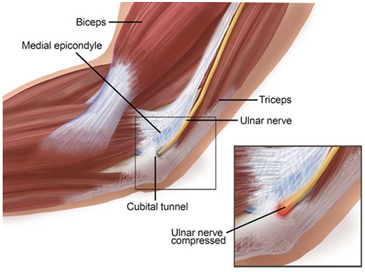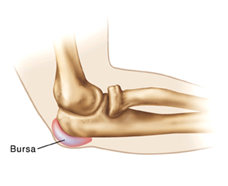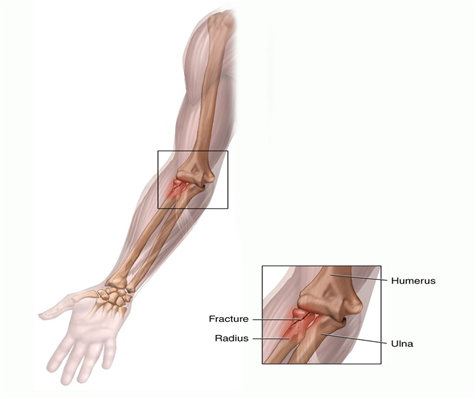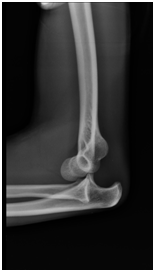Elbow
Medial Epicondylitis
Medial epicondylitis or “Golfer’s elbow” is an elbow condition that typically arises from some sort of repetitive motion; most commonly gripping and grasping. With continuous and forceful flexion of the wrist the tendons of your forearm flexor muscles get overworked and develop small tears and inflammation. Symptoms are mostly on the inside of the elbow and along the palmer muscle mass of your forearm. Diagnosis is usually made through physical exam, although an MRI is helpful.
Treatment for this issue is usually non-surgical, although there is a surgical option for refractory cases. Basis for treatment includes reducing inflammation, either with oral anti-inflammatory pills or a cortisone injection, and good stretching of the affected muscles. Physical therapy is also helpful and braces are available to provide compression and support to this area.
While this can be a stubborn condition, most patients do well with conservative care. Should symptoms continue despite appropriate treatment, option for surgical debridement to this area is available. Another relatively new and affective treatment for chronic medial epicondylitis is PRP (platelet rich plasma) injections.
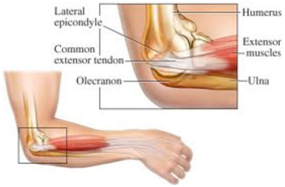
Lateral Epicondylitis
Lateral epicondylitis or “Tennis elbow” is an elbow condition that typically arises from some sort of repetitive motion; most commonly grasping, pushing, pulling and lifting. With continuous and forceful extension of the wrist the tendons of your forearm extensor muscles get overworked and develop small tears and inflammation. Symptoms are mostly on the outside of the elbow and can extend down to the muscles of your forearm. Diagnosis is usually made through physical exam, although an MRI is helpful.
Treatment for this issue is usually non-surgical, although there is a surgical option for refractory cases. Basis for treatment includes reducing inflammation, either with oral anti-inflammatory pills or a cortisone injection, and good stretching of the extensor muscles. Physical therapy is also helpful and braces are available to provide compression and support to this area.
While this can be a stubborn condition, most patients do well with conservative care. Should symptoms continue despite appropriate treatment, option for surgical debridement to this area is available. Another relatively new and effective treatment for chronic lateral epicondylitis is PRP (platelet rich plasma) injections. Please head to our section on PRP to read more about this.
Cubital Tunnel Syndrome
Cubital tunnel syndrome is the compression of the ulnar nerve across the elbow. There are several things that can cause this condition. It can occur from direct trauma, constant or repetitive pressure over the nerve, or with prolonged or recurrent flexion of the elbow. While this location of this issue is in the elbow, the majority of symptoms are actually felt in the hand. Most often people complain of numbness and tingling in the ring and small finger on the affected side. It is your ulnar nerve that gives sensation to this area and when it is pinched, the fingers become affected. People tend to complain of decreased grip strength, loss of coordination with gripping and grasping activities, and decreased sensation. If nerve compression is severe, or has been present for a long time, muscle atrophy in the hand can be seen.
Diagnosis is made clinically with a physical exam, although MRIs and nerve conduction studies are also helpful. Treatment depends on severity of symptoms. If muscle wasting has occurred, urgent surgical release should be done to prevent further deterioration in nerve function. This involves opening up the cubital tunnel, releasing the nerve from surrounding scar tissue, and repositioning the nerve to avoid recurrent compression. Mild symptoms can be handled conservatively with anti-inflammatories, physical therapy and bracing.
Olecranon Bursa
The bursa in your elbow is a small fluid filled sac that lies under your skin just above the tip of your elbow. It provides cushioning and lubrication to the elbow. Inflammation to this area is called bursitis. It can occur from trauma, prolonged pressure on this area, or infection. Condition often appears has painful swelling over the elbow. Range of motion is generally not affected. If infection in present, redness and tenderness may be noted.
Diagnosis is made through physical exam. MRIs are typically not needed. Plain film X-rays are done to rule out any spurring of the olecranon bone, which can predispose you to developing bursitis. Treatment involves compression, ice, activity modification, as well as anti-inflammatory medication. Most often, patients require aspiration of the bursa to remove the accumulated fluid. At the same time as aspiration, an injection of a small amount of cortisone is given inside the bursa to reduce inflammation and prevent recurrence. If there is evidence of infection, antibiotics will likely be started after the aspiration is complete.
Should this problem become chronic, repeat aspirations may be needed. Surgical option for bursectomy is also available. This involves actually removing the scarred and inflamed bursal sac. Majority of patients have improvement with simple aspiration, surgery is not routinely needed.
Radial head and neck fractures
Radial head and neck fractures occur in about 20% of all elbow injuries, most often after a fall. Symptoms associated with this type of injury include pain over the outside of the elbow, swelling, bruising, difficulty with range of motion, and pain when rotating your forearm. X-ray and CT scans confirm the diagnosis.
Fractures to the radial head and neck are classified according to size, location, and degree of bone displacement. The majority of these fractures can be treated conservatively with short-term immobilization, ice and rest followed by physical therapy. However, depending of the nature of the fracture, surgery may be indicated.
Elbow Dislocations
Elbow dislocations are uncommon, but often result from a fall onto an outstretched hand. Dislocations are categorized into simple, complex and severe. Simple dislocations involve no injury to the bone. Complex dislocations involve both bone and ligament injury. Severe dislocations involve injury to the important nerves and vessels in the area. X-ray and CT scans confirm the diagnosis.
Symptoms associated with this injury include painful and obvious deformity to the elbow. Manual reduction of the joint will need to be performed and is usually done in an emergency room or urgent care setting.
Simple elbow dislocations are treated with short-term sling immobilization followed by early range of motion exercises with a physical therapist. Even after physical therapy, however, patients may not be able to gain full extension of the elbow. Fortunately, the elbow will still function quite well with this limitation. Complex and severe elbow dislocations most often require surgery for stabilization and fixation of bone and ligament injuries.

